Investigation on the Failure Mechanism of Rainfall-Induced Long-Runout Landslide at Upputhode, Kerala State of India
Abstract
:1. Introduction
2. Slope Failure in Upputhode
3. Rainfall
4. Field and Laboratory Test
4.1. Field Test
4.2. Laboratory Tests
4.3. Study on Weathering Characteristics
5. Evaluation of Residual Shear Strength Parameters of Soil at Slip Surface through Ring Shear Test
6. Integrated Landslide Simulation Model Using LS-RAPID
Parametric Study of Landslide Using Landslide Depth and Pore Water Pressure Ratio
7. Deterministic Analysis of Probable Landslide in Nearby Area Using LS-RAPID
8. Threshold Analysis
Threshold Based on Antecedent Rainfall
9. Results
9.1. Results of Field and Laboratory Test
9.1.1. Field Test
9.1.2. Laboratory Test
9.1.3. Weathering Characteristics
9.2. Results of Ring Shear Test
9.3. Results of Simulation Analysis
9.4. Deterministic Analysis through LS-RAPID
9.5. Threshold Based on Antecedent Rainfall
10. Discussions
11. Conclusions
- The subsurface profile of the landslide was studied to know the depth of the soil layers. From the MASW test of geophysical investigation, the subsurface profile of the landslide mass was obtained. The topsoil was classified as silty sand (SM), which is loose and unconsolidated in nature. The second layer was classified as stiff sand (SP). The presence of stiff sand extended up to 6 m, and this can be clearly visible in the after-event of a landslide, as the landslide is classified as a shallow landslide.
- The field investigation and geotechnical characterization of the soil in the slip surface revealed that the soil is silty sand (SM) with a considerable amount of kaolinite clay particles due to the intense weathering of the parent biotite gneiss. The increase in fine soil helps in the increase in pore water pressure in the soil and thereby reduces the matric suction. The X-ray diffraction (XRD) of the topsoil shows the presence of kaolinite clay and aluminum oxide. This is due to the presence of feldspar and gibbsite in the parent rock and the second layer of soil, which, when weathered, is reduced to clay components and aluminum oxide in the soil. When the iron oxide in the form of hematite (Fe2O3) reacts with the aluminum oxide in the presence of water for a long period of time, they precipitate into aluminum silicates or ferroaluminum silicates. This crystallized reaction will bind two adjacent particles, forming a solidified product in the dry season. This makes the soil stiff in the dry season.
- The steady-state shear resistance of this type of soil in the slip surface is estimated from the ring shear test. This helps in modeling the landslide in the region as there will be only deformation observed without any resistance. This was due to an increase in the pore water pressure in the soil due to the prolonged rainfall.
- The numerical simulation of the landslide revealed that the initiation of the landslide was caused by the increase in pore water pressure of the soil. The soil displacement occurs when the pore water pressure attains a point where the strength is reduced to the residual shear strength. The soil slope failed in a pore water pressure ratio of ru = 0.32, and it can be seen from the simulation that the velocity of the soil down the slope is greater due to the steep gradient. The soil was saturated due to the antecedent rainfall along the slope, which caused the soil to slide.
- The probabilistic location of the landslide nearby the Upputhode landslide area was studied through LS-RAPID. It was found that there is an unstable landmass in the location at 9°52′40.12″ N and 77°00′21.59″ E. The probabilistic landslide shows that the run-out length extends to the nearby locality if the pore water pressure ratio crosses 0.35–0.4.
- The rainfall threshold analysis revealed that to trigger the landslide, either a high daily rainfall intensity of 142 mm is required without any antecedent rainfall or a continuous low-intensity rainfall of 151 mm for a cumulative period of 5 days with normal continuous rainfall can initiate landslide.
Author Contributions
Funding
Institutional Review Board Statement
Informed Consent Statement
Data Availability Statement
Acknowledgments
Conflicts of Interest
References
- Cho, S.E. Stability analysis of unsaturated soil slopes considering water-air flow caused by rainfall infiltration. Eng. Geol. 2016, 211, 184–197. [Google Scholar] [CrossRef]
- Ering, P.; Babu, G.L.S. Probabilistic back analysis of rainfall induced landslide—A case study of Malin landslide, India. Eng. Geol. 2016, 208, 154–164. [Google Scholar] [CrossRef]
- Sun, D.-M.; Li, X.-M.; Feng, P.; Zang, Y.-G. Stability analysis of unsaturated soil slope during rainfall infiltration using coupled liquid-gas-solid three-phase model. Water Sci. Eng. 2016, 9, 183–194. [Google Scholar] [CrossRef]
- Gofar, N.; Rahardjo, H. Saturated and unsaturated stability analysis of slope subjected to rainfall infiltration. MATEC Web Conf. 2017, 101, 5004. [Google Scholar] [CrossRef] [Green Version]
- Yang, K.H.; Uzuoka, R.; Lin, G.L.; Nakai, Y. Coupled hydro-mechanical analysis of two unstable unsaturated slopes subject to rainfall infiltration. Eng. Geol. 2017, 216, 13–30. [Google Scholar] [CrossRef]
- Morgenstern, N.R.; Martin, C.D. Landslides: Seeing the ground. Landslides Eng. Slopes. Past Futur. Two Vol. 2008, 25–46. [Google Scholar] [CrossRef]
- Huy, L.D.; Sassa, K.; Fukuoka, H.; Sato, Y.; Takara, K.; Setiawan, H.; Pham, T.; Dang, K. TXT-tool 3.081-1.4 initiation mechanism of rapid and long run-out landslide and simulation of hiroshima landslide disasters using the integrated simulation model (LS-rapid). In Landslide Dynamics: ISDR-ICL Landslide Interactive Teaching Tools; Springer: Cham, Switzerland , 2018; Volume 2. [Google Scholar]
- Thennavan, E.; Pattukandan Ganapathy, G. Evaluation of landslide hazard and its impacts on hilly environment of the Nilgiris District—A geospatial approach. Geoenviron. Disasters 2020, 7, 1–14. [Google Scholar] [CrossRef]
- Kanungo, D.; Sharma, S. Rainfall thresholds for prediction of shallow landslides around Chamoli-Joshimath region, Garhwal Himalayas. Landslides 2014, 11, 629–638. [Google Scholar] [CrossRef]
- Harilal, G.T.; Madhu, D.; Ramesh, M.V.; Pullarkatt, D. Towards establishing rainfall thresholds for a real-time landslide early warning system in Sikkim, India. Landslides 2019, 16, 2395–2408. [Google Scholar] [CrossRef]
- Senthilkumar, S.; Maji, V.; Chandrasekaran, V. Geotechnical characterization and analysis of rainfall—induced 2009 landslide at Marappalam area of Nilgiris district, Tamil Nadu state, India. Landslides 2017, 14, 1803–1814. [Google Scholar] [CrossRef]
- Vadivel, S.; Sennimalai, C.S. Failure Mechanism of Long-Runout Landslide Triggered by Heavy Rainfall in Achanakkal, Nilgiris, India. J. Geotech. Geoenviron. Eng. 2019, 145, 04019047. [Google Scholar] [CrossRef]
- Yang, H.; Wang, F.; Vilímek, V.; Araiba, K.; Asano, S. Investigation of rainfall-induced shallow landslides on the northeastern rim of Aso caldera, Japan, in July 2012. Geoenviron. Disasters 2015, 2, 1–14. [Google Scholar] [CrossRef] [Green Version]
- Lu, N.; Likos, W.J. Suction stress characteristic curve for unsaturated soil. J. Geotech. Geoenviron. Eng. 2006, 132, 131–142. [Google Scholar] [CrossRef] [Green Version]
- Rahardjo, H.; Kim, Y.; Satyanaga, A. Role of unsaturated soil mechanics in geotechnical engineering. Int. J. Geo-Eng. 2019, 10, 1–23. [Google Scholar] [CrossRef] [Green Version]
- Jeggle, T.; Boggero, M. Post-Disaster Needs Assessment; World Bank: Washington, DC, USA, 2018. [Google Scholar]
- Sajinkumar, K.S.; Asokakumar, M.R.; Sajeev, R.; Venkatraman, N. V A potential headward retreat landslide site at Munnar, Kerala. J. Geol. Soc. India 2017, 89, 183–191. [Google Scholar] [CrossRef]
- Weidner, L.; Oommen, T.; Escobar-Wolf, R.; Sajinkumar, K.S.; Samuel, R.A. Regional-scale back-analysis using TRIGRS: An approach to advance landslide hazard modeling and prediction in sparse data regions. Landslides 2018, 15, 2343–2356. [Google Scholar] [CrossRef]
- Agarwal, R. Original Research Article Lesson Learned from Killer Floods in Kerala: Time for Retrospection. Manag. Econ. Res. J. 2018, 4, 268–280. [Google Scholar] [CrossRef]
- Megha, V.; Joshi, V.; Kakde, N.; Jaybhaye, A.; Dhoble, D. Flood Mapping and Analysis using Sentinel Application Platform (SNAP)-A Case Study of Kerala. Int. J. Res. Eng. Sci. Manag. 2019, 2, 486–488. [Google Scholar]
- Vishnu, C.L.; Sajinkumar, K.S.; Oommen, T.; Coffman, R.A.; Thrivikramji, K.P.; Rani, V.R.; Keerthy, S. Satellite-based assessment of the August 2018 flood in parts of Kerala, India. Geomat. Nat. Hazards Risk 2019, 10, 758–767. [Google Scholar] [CrossRef] [Green Version]
- Sankar, G. Monsoon Fury in Kerala—A Geo-environmental Appraisal. J. Geol. Soc. India 2018, 92, 383–388. [Google Scholar] [CrossRef]
- Mishra, V.; Aaadhar, S.; Shah, H.; Kumar, R.; Pattanaik, D.R.; Tiwari, A.D. The Kerala flood of 2018: Combined impact of extreme rainfall and reservoir storage. Hydrol. Earth Syst. Sci. Discuss. 2018, 2018, 1–13. [Google Scholar] [CrossRef] [Green Version]
- Krishnanath, R.; Sreenath, G.; Biju Abraham, P. Seepage Modeling and Slope Stability analysis at Devikulam–Manale profile along Kumili–Munnar road in Idukki district, Kerala. Indian Jour. Environ. Pollut. 1996, 3, 215–220. [Google Scholar]
- Krishnanath, R.; Sreekumar, S. Identification and location of slide prone areas in certain hard rock profiles of Western Ghats. Indian Geotech. J. 1996, 26, 407–416. [Google Scholar]
- Sreekumar, S.; Krishnanath, R. Stability of Lateritic profiles in parts of Western Ghats, India. In Landslides Research: Theory and Practice; Thomas Telford Ltd.: London, UK, 2000; Volume 3, pp. 1395–1400. [Google Scholar]
- Sankar, S. Investigation of landslides in Kodaranji and Kurachundu; Calicut District Report CESS: Trivandrum, India, 1991. [Google Scholar]
- Sajinkumar, K.S.; Anbazhagan, S.; Pradeepkumar, A.P.; Rani, V.R. Weathering and landslide occurrences in parts of Western Ghats, Kerala. J. Geol. Soc. India 2011, 78, 249–257. [Google Scholar] [CrossRef]
- Sajinkumar, K.S. Geoinformatics in Landslide Risk Assessment and Management in Parts of Western Ghats, Central Kerala, South India. Unpubl. Ph. D. Thesis, Indian Institute of Technology (IIT), Mumbai, India, 2005. [Google Scholar]
- Biju Abraham, P.; Shaji, E. Landslide hazard zonation in and around Thodupuzha-Idukki-Munnar road, Idukki district, Kerala: A geospatial approach. J. Geol. Soc. India 2013, 82, 649–656. [Google Scholar] [CrossRef]
- Sajinkumar, K.S.; Anbazhagan, S. Geomorphic appraisal of landslides on the windward slope of Western Ghats, southern India. Nat. Hazards 2015, 75, 953–973. [Google Scholar] [CrossRef]
- Hungr, O.; Leroueil, S.; Picarelli, L. The Varnes classification of landslide types, an update. Landslides 2014, 11, 167–194. [Google Scholar] [CrossRef]
- IndianExpress News. Available online: http://www.Indianexpress.in (accessed on 15 August 2018).
- Kuriakose, S.L.; Jetten, V.G.; van Westen, C.J.; Sankar, G.; van Beek, L.P.H. Pore Water Pressure as a Trigger of Shallow Landslides in the Western Ghats of Kerala, India: Some Preliminary Observations from an Experimental Catchment. Phys. Geogr. 2008, 29, 374–386. [Google Scholar] [CrossRef]
- India Meteorological Department. IMD Malappuram District Rainfall for Last Five Years. Available online: http://www.imd.gov.in/section/hydro/distrainfall/webrain/Kerala/Malappuram (accessed on 15 August 2018).
- Park, C.B.; Miller, R.D.; Xia, J. Multichannel analysis of surface waves. Geophysics 1999, 64, 800–808. [Google Scholar] [CrossRef] [Green Version]
- Dey, A. Subsurface Profiling using MASW: Aspects of Data Acquisition, Dispersion and Inversion Analyses 1 Introduction 2 Multichannel Analysis of Surface waves. In Proceedings of the QIP-STC on Challenges and Recent Advances in Geotechnical Engineering Research and Practices, Guwahati, India, 13 March 2015; pp. 1–17. [Google Scholar]
- Regmi, A.D.; Yoshida, K.; Dhital, M.R.; Devkota, K. Effect of rock weathering, clay mineralogy, and geological structures in the formation of large landslide, a case study from Dumre Besei landslide, Lesser Himalaya Nepal. Landslides 2013, 10, 1–13. [Google Scholar] [CrossRef] [Green Version]
- Park, C.B.; Miller, R.D.; Miura, H. Optimum field parameters of an MASW survey. Proc. Soc. Explor. Geophys. Jpn. Tokyo 2002, 22, 23. [Google Scholar]
- Foti, S.; Hollender, F.; Garofalo, F.; Albarello, D.; Asten, M.; Bard, P.Y.; Comina, C.; Cornou, C.; Cox, B.; Di Giulio, G.; et al. Guidelines for the good practice of surface wave analysis: A product of the InterPACIFIC project. Bull. Earthq. Eng. 2018, 16, 2367–2420. [Google Scholar] [CrossRef]
- Park, C.B.; Miller, R.D.; Xia, J. Imaging dispersion curves of surface waves on multi-channel record. In Proceedings of the 1998 SEG Annual Meeting, New Orleans, LA, USA, 13 September 1998. [Google Scholar] [CrossRef]
- Cuisinier, O.; Auriol, J.C.; Le Borgne, T.; Deneele, D. Microstructure and hydraulic conductivity of a compacted lime-treated soil. Eng. Geol. 2011, 123, 187–193. [Google Scholar] [CrossRef]
- Cetin, H. Soil-particle and pore orientations during consolidation of cohesive soils. Eng. Geol. 2004, 73, 1–11. [Google Scholar] [CrossRef]
- Al-Mukhtar, M.; Khattab, S.; Alcover, J.F. Microstructure and geotechnical properties of lime-treated expansive clayey soil. Eng. Geol. 2012, 139–140, 17–27. [Google Scholar] [CrossRef]
- Alonso, E.; Pinyol, N.; Gens, A. Compacted soil behaviour: Initial state, structure and constitutive modelling. Géotechnique 2013, 63, 463–478. [Google Scholar] [CrossRef] [Green Version]
- ASTM. 6467: Standard Test Method for Torsional Ring Shear Test to Determine Drained Residual Shear Strength of Cohesive Soils; ASTM: West Conshohocken, PA, USA, 2013. [Google Scholar]
- Stark, T.D.; Vettel, J.J. Bromhead ring shear test procedure. Geotech. Test. J. 1992, 15, 24–32. [Google Scholar]
- Stark, T.D.; Contreras, I.A. Constant volume ring shear apparatus. Geotech. Test. J. 1996, 19, 3–11. [Google Scholar]
- Li, D.; Yin, K.; Glade, T.; Leo, C. Effect of over-consolidation and shear rate on the residual strength of soils of silty sand in the Three Gorges Reservoir. Sci. Rep. 2017, 7, 1–11. [Google Scholar]
- Sassa, K.; Nagai, O.; Solidum, R.; Yamazaki, Y.; Ohta, H. An integrated model simulating the initiation and motion of earthquake and rain induced rapid landslides and its application to the 2006 Leyte landslide. Landslides 2010, 7, 219–236. [Google Scholar]
- Sassa, K.; Setiawan, H.; He, B.; Gradiški, K.; Dang, K. TXT-tool 3.081-1.5: Manual for the LS-RAPID software. In Landslide dynamics: ISDR-ICL Landslide Interactive Teaching Tools; Springer: Berlin/Heidelberg, Germany, 2018; pp. 191–224. [Google Scholar]
- Wang, F.; Sassa, K. Landslide simulation by a geotechnical model combined with a model for apparent friction change. Phys. Chem. Earth Parts A/B/C 2010, 35, 149–161. [Google Scholar] [CrossRef]
- Dang, K.; Sassa, K.; Fukuoka, H.; Sakai, N.; Sato, Y.; Takara, K.; Quang, L.H.; Loi, D.H.; Van Tien, P.; Ha, N.D. Mechanism of two rapid and long-runout landslides in the 16 April 2016 Kumamoto earthquake using a ring-shear apparatus and computer simulation (LS-RAPID). Landslides 2016, 13, 1525–1534. [Google Scholar] [CrossRef]
- Dugonjić Jovančević, S.; Nagai, O.; Sassa, K.; Arbanas, Ž. TXT-tool 3.385-1.2: Deterministic Landslide Susceptibility Analyses Using LS-Rapid Software. In Landslide Dynamics: ISDR-ICL Landslide Interactive Teaching Tools; Sassa, K., Tiwari, B., Liu, K.-F., McSaveney, M., Strom, A., Setiawan, H., Eds.; Springer: Cham, Switzerland, 2018; Volume 2, Testing, Risk Management and Country Practices; pp. 169–179. ISBN 978-3-319-57777-7. [Google Scholar]
- Setiawan, H.; Sassa, K.; Takara, K.; Oštrić, M.; Miyagi, T.; Fukuoka, H. TXT-tool 4.081-1.2: Mechanism of the Aratozawa Large-Scale Landslide Induced by the 2008 Iwate-Miyagi Earthquake. In Landslide Dynamics: ISDR-ICL Landslide Interactive Teaching Tools; Springer: Cham, Switzerland, 2018; pp. 819–831. [Google Scholar]
- Soilgrids.org. Available online: http://www.soilgrids.org (accessed on 20 August 2021).
- Varnes, D.J. Slope movement types and processes. Spec. Rep. 1978, 176, 11–33. [Google Scholar]
- Guidicini, G.; Iwasa, O.Y. Tentative correlation between rainfall and landslides in a humid tropical environment. Bull. Int. Assoc. Eng. Geol. 1977, 16, 13–20. [Google Scholar] [CrossRef]
- Corominas, J.; Moya, J. Historical landslides in the Eastern Pyrenees and their relation to rainy events. In Proceedings of the Eight International Conference and Field Trip on Landslides, Granada, Spain, 27–28 September 1996; pp. 125–132. [Google Scholar]
- Guzzetti, F.; Peruccacci, S.; Rossi, M.; Stark, C.P. Rainfall thresholds for the initiation of landslides in central and southern Europe. Meteorol. Atmos. Phys. 2007, 98, 239–267. [Google Scholar]
- Sengupta, A.; Gupta, S.; Anbarasu, K. Rainfall thresholds for the initiation of landslide at Lanta Khola in north Sikkim, India. Nat. Hazards 2010, 52, 31–42. [Google Scholar] [CrossRef]
- Crosta, G. Regionalization of rainfall thresholds: An aid to landslide hazard evaluation. Environ. Geol. 1998, 35, 131–145. [Google Scholar] [CrossRef]
- Thiebes, B. Landslide Analysis and Early Warning Systems: Local and Regional Case Study in the Swabian Alb, Germany; Springer: Berlin/Heidelberg, Germany, 2012; ISBN 3642275265. [Google Scholar]
- Crozier, M.J. Prediction of rainfall-triggered landslides: A test of the Antecedent Water Status Model. Earth Surf. Process. Landforms 1999, 24, 825–833. [Google Scholar] [CrossRef]
- Rahardjo, H.; Li, X.W.; Toll, D.G.; Leong, E.C. The effect of antecedent rainfall on slope stability. In Unsaturated Soil Concepts and Their Application in Geotechnical Practice; Toll, D.G., Ed.; Springer Netherlands: Dordrecht, The Netherlands, 2001; pp. 371–399. ISBN 978-94-015-9775-3. [Google Scholar]
- Jaiswal, P.; Westen, C.J. Van Quantitative assessment of landslide hazard along transportation lines using historical records. Landslides 2011, 8, 279–291. [Google Scholar] [CrossRef]
- Zêzere, J.L.; Trigo, R.M.; Trigo, I.F. Shallow and deep landslides induced by rainfall in the Lisbon region (Portugal): Assessment of relationships with the North Atlantic Oscillation. Nat. Hazards Earth Syst. Sci. 2005, 5, 331–344. [Google Scholar] [CrossRef]
- Sajinkumar, K.S.; Castedo, R.; Sundarajan, P.; Rani, V.R. Study of a partially failed landslide and delineation of piping phenomena by vertical electrical sounding (VES) in the Wayanad Plateau, Kerala, India. Nat. Hazards 2015, 75, 755–778. [Google Scholar] [CrossRef]
- Kuriakose, S.L.; Sankar, G.; Muraleedharan, C. History of landslide susceptibility and a chorology of landslide-prone areas in the Western Ghats of Kerala, India. Environ. Geol. 2009, 57, 1553–1568. [Google Scholar] [CrossRef]
- Muraleedharan, C.; Sajinkumar, K.S. Landslide inventory of Kerala. In Government of India Geological Survey of India LANDSLIDE; Geological Survey of India: Kolkata, India, 2010; pp. 1–77. [Google Scholar]
- Sanjeev, R.; Maruthi, K.V.; Sajinkumar, K.S. Detailed Site Specific Study of Konnathadi Debris Avalanche, Idukki District, Kerala; GSI Thiruvananthapuram: Thiruvananthapuram, India, 2013.
- Ivanov, J.; Park, C.B.; Miller, R.D.; Xia, J.; Overton, R. Modal Separation Before Dispersion Curve Extraction by MASW Method. In Proceedings of the 14th EEGS Symposium on the Application of Geophysics to Engineering and Environmental Problems, Denver, CO, USA, 4–7 March 2001. [Google Scholar]
- NEHRP. NEHRP Recommended Provisions for Seismic Regulations for New Buildings and Other Structures (Fema 450); NEHRP: Washington, DC, USA, 2003.
- ASTM D2487-11. In Standard Practice for Classification of Soils for Engineering Purposes (Unified Soil Classification System); American Society for Testing and Materials: West Conshohocken, PA, USA, 2011; p. 5.
- IS2720(17) Indian Standard Methods of Tests for Soils: Laboratory Determination of Permeability; Bureau of Indian Standards: New Delhi, India, 1986.
- ASTM. D18 Committee Test Method for Direct Shear Test of Soils Under Consolidated Drained Conditions; ASTM: West Conshohocken, PA, USA, 1900. [Google Scholar]
- Le Pera, E.; Arribas, J.; Critelli, S.; Tortosa, A. The effects of source rocks and chemical weathering on the petrogenesis of siliciclastic sand from the Neto River (Calabria, Italy): Implications for provenance studies. Sedimentology 2001, 48, 357–378. [Google Scholar] [CrossRef]
- Glossary of Geology. Soil Sci. Soc. Am. J. 1974, 38, 4–6. [CrossRef]
- Wakatsuki, T.; Tanaka, Y.; Matsukura, Y. Soil slips on weathering-limited slopes underlain by coarse-grained granite or fine-grained gneiss near Seoul, Republic of Korea. Catena 2005, 60, 181–203. [Google Scholar] [CrossRef]
- White, A.F.; Bullen, T.D.; Schulz, M.S.; Blum, A.E.; Huntington, T.G.; Peters, N.E. Differential rates of feldspar weathering in granitic regoliths. Geochim. Cosmochim. Acta 2001, 65, 847–869. [Google Scholar] [CrossRef]
- Rajan, P.K.; Santosh, M.; Ramachandran, K.K. Geochemistry and petrogenetic evolution of the diatexites of Central Kerala, India. Proc. Indian Acad. Sci. Earth Planet. Sci. 1984, 93, 57–69. [Google Scholar] [CrossRef] [Green Version]
- Skempton, A.W. Residual strength of clays in landslides, folded strata and the laboratory. Geotechnique 1985, 35, 3–18. [Google Scholar] [CrossRef]
- Jaiswal, P.; van Westen, C.J. Estimating temporal probability for landslide initiation along transportation routes based on rainfall thresholds. Geomorphology 2009, 112, 96–105. [Google Scholar] [CrossRef]

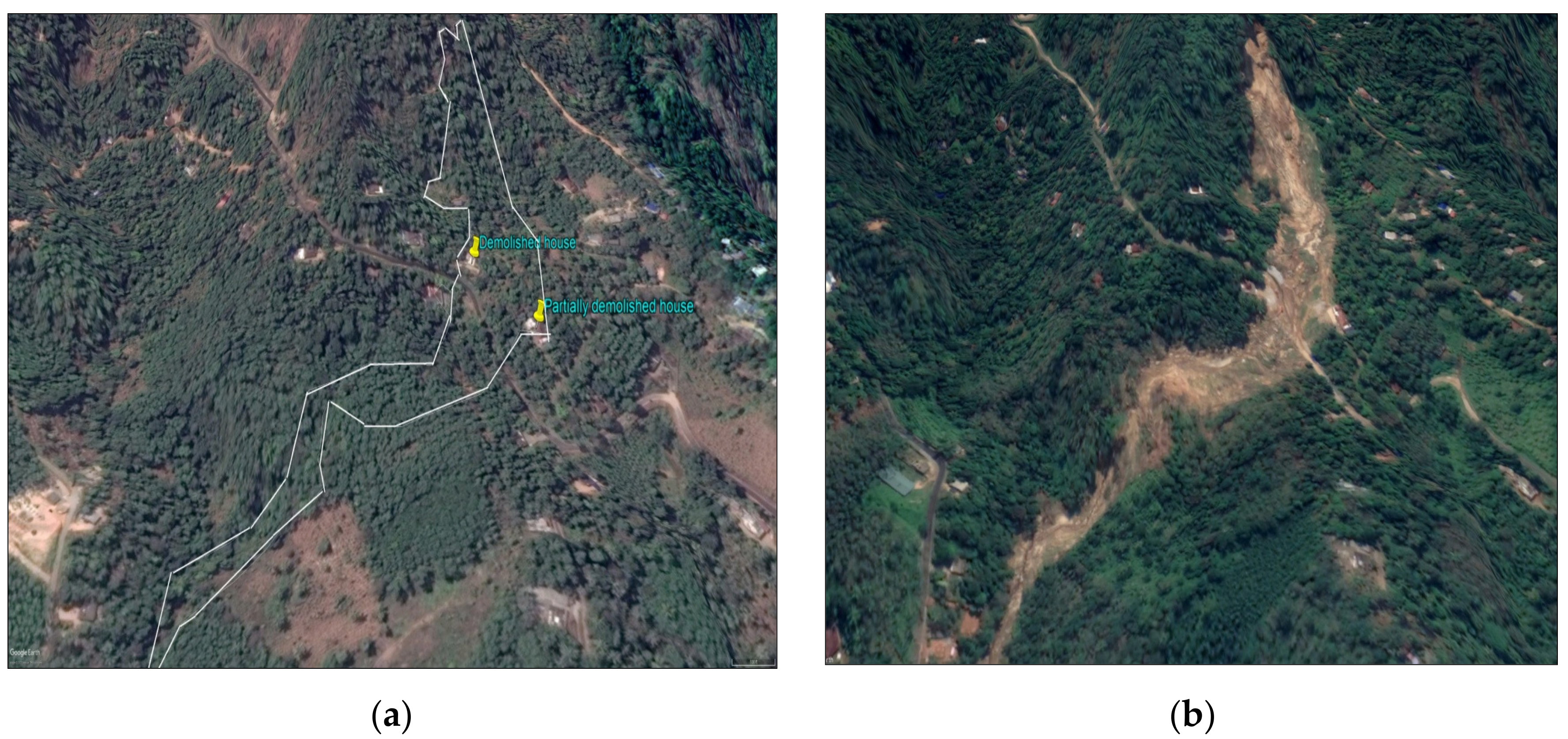
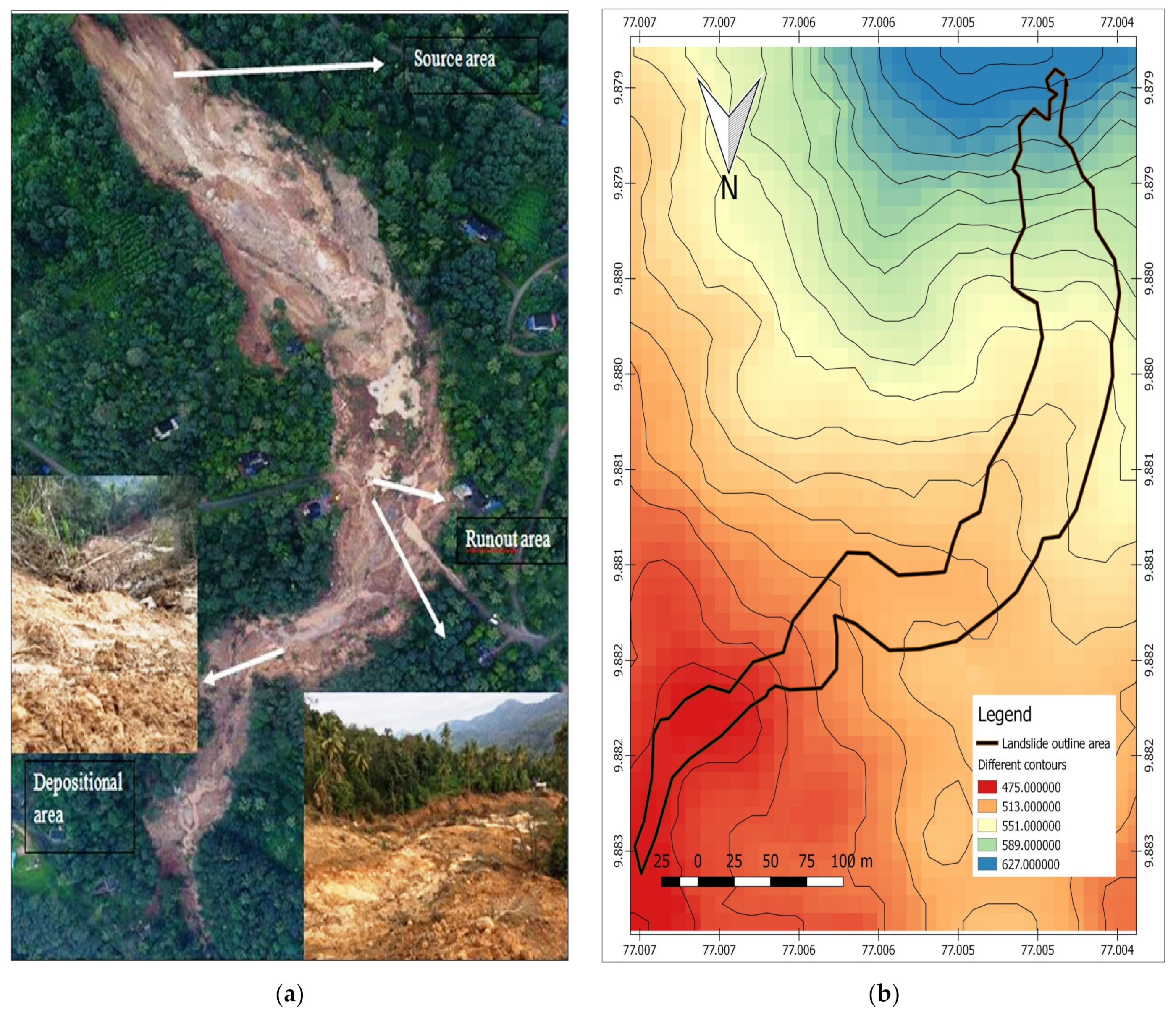
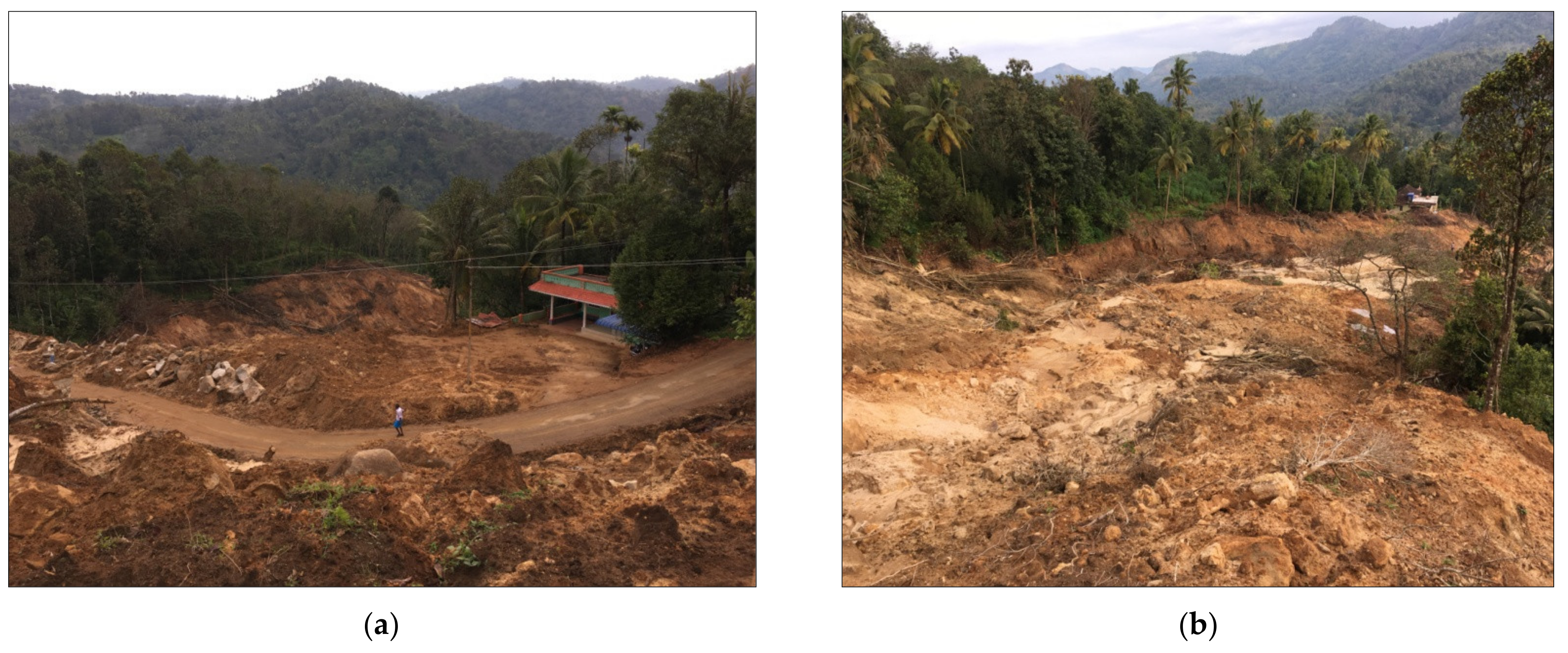
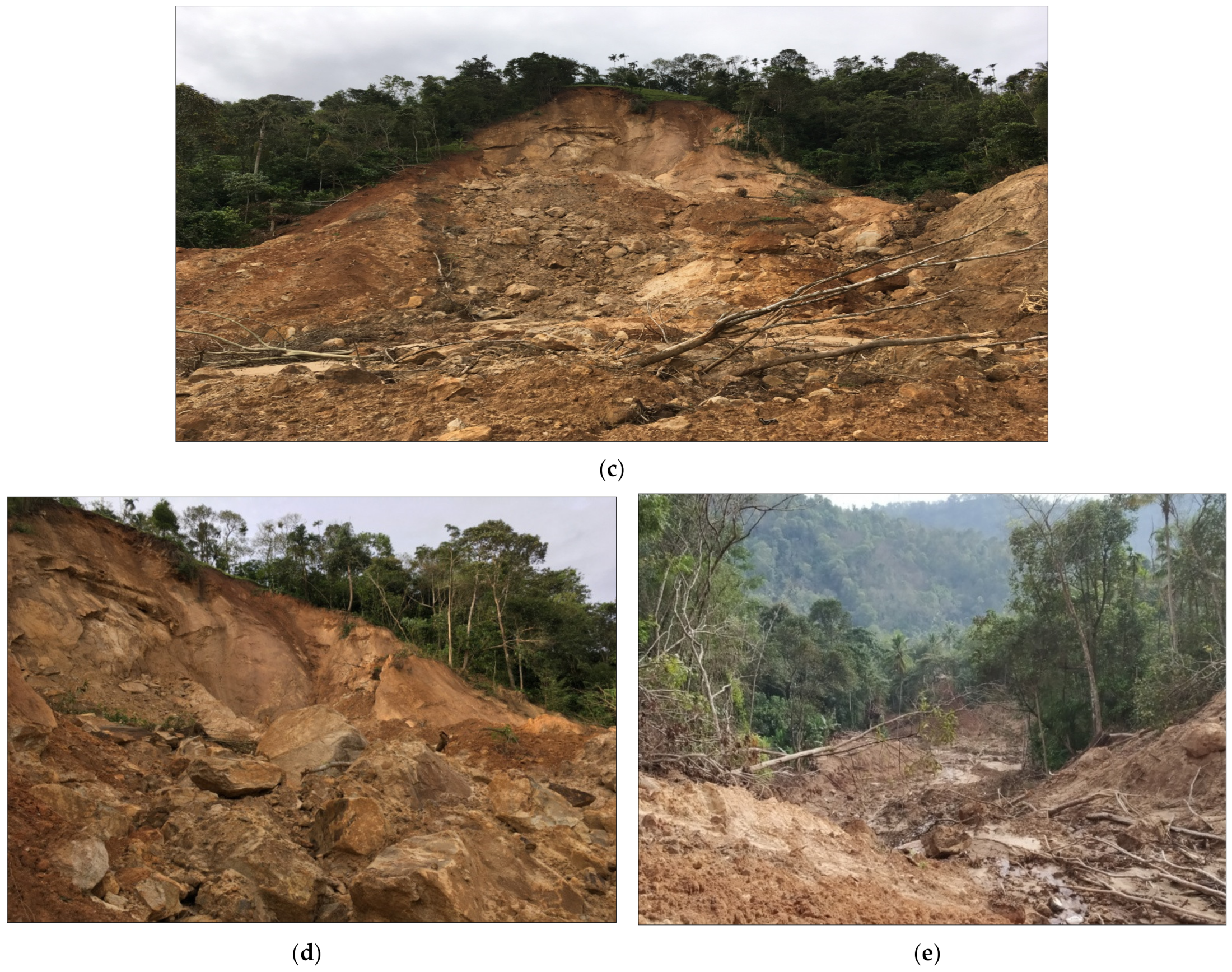
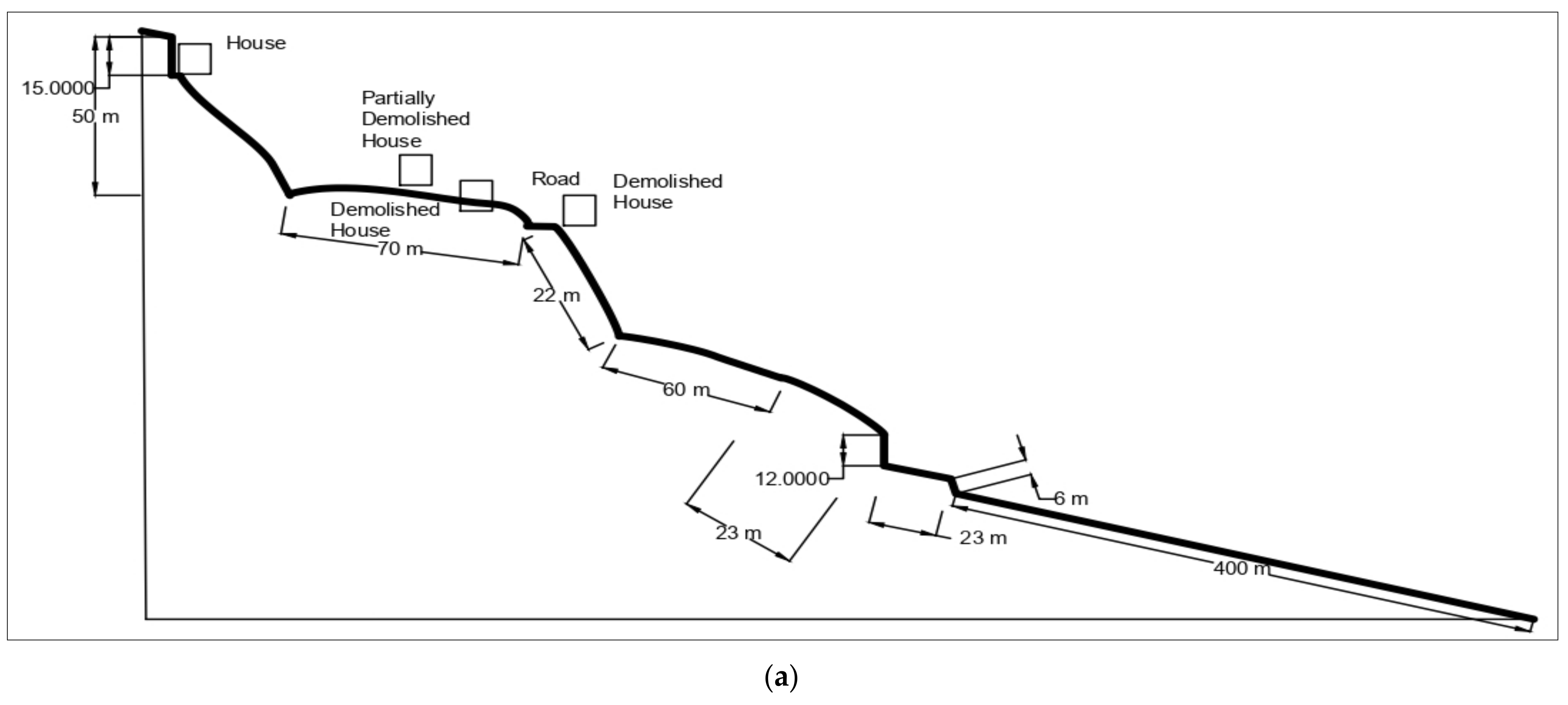

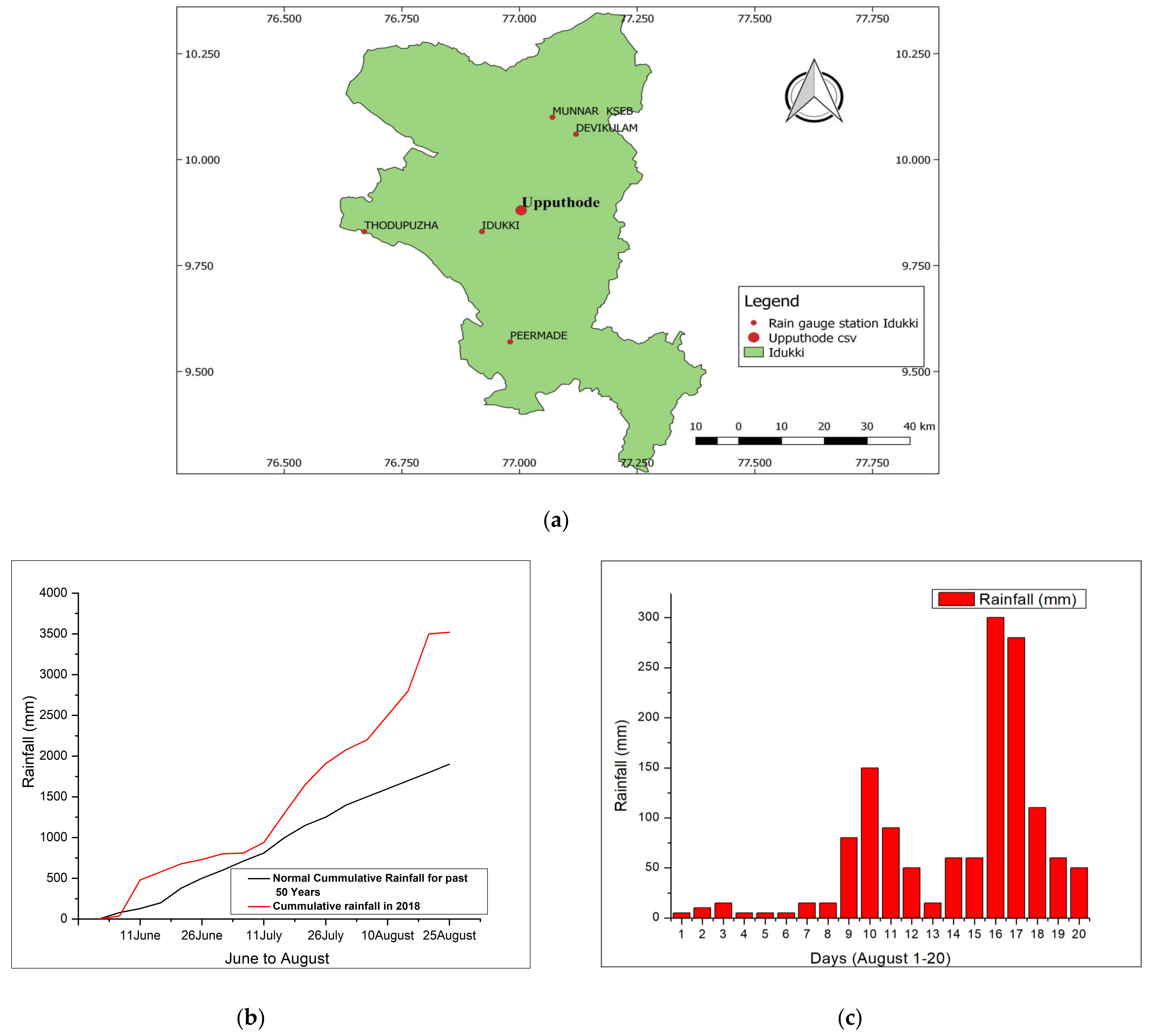

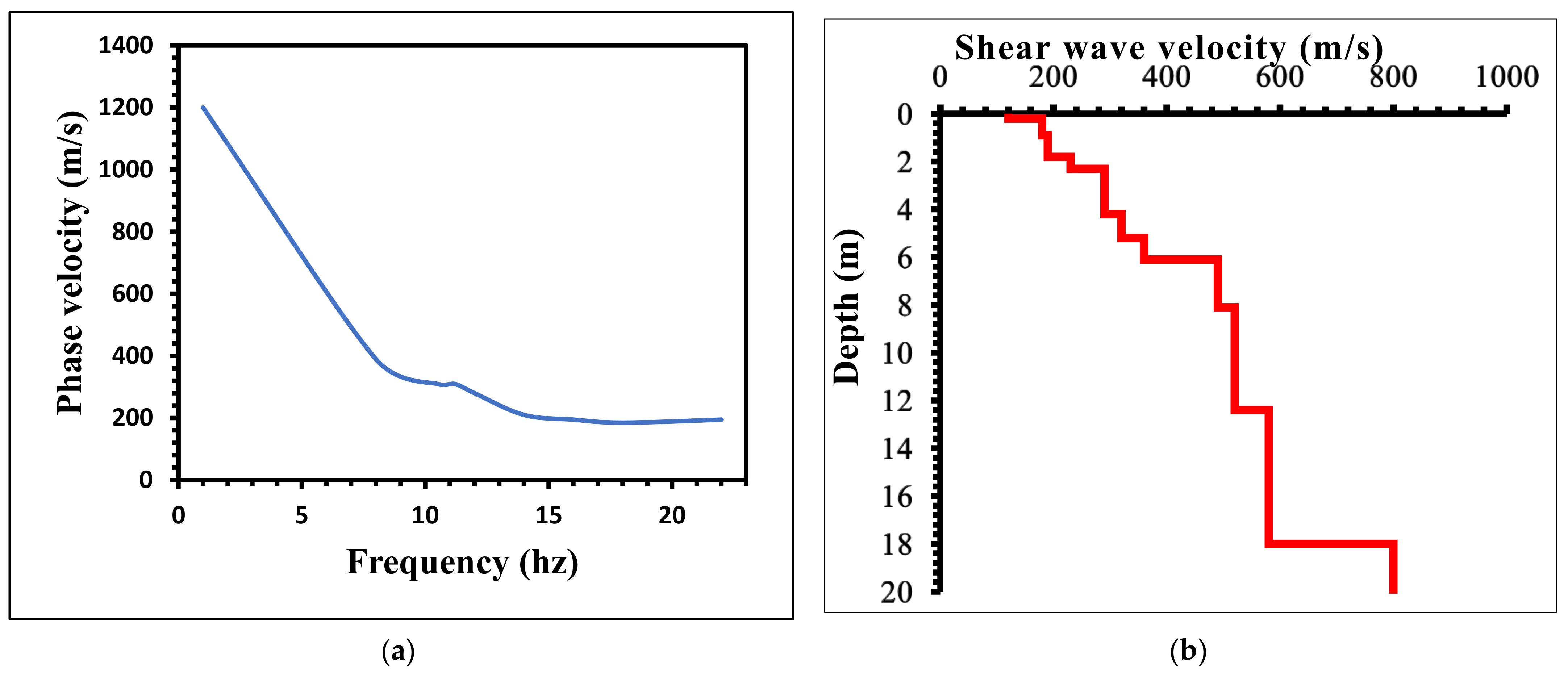

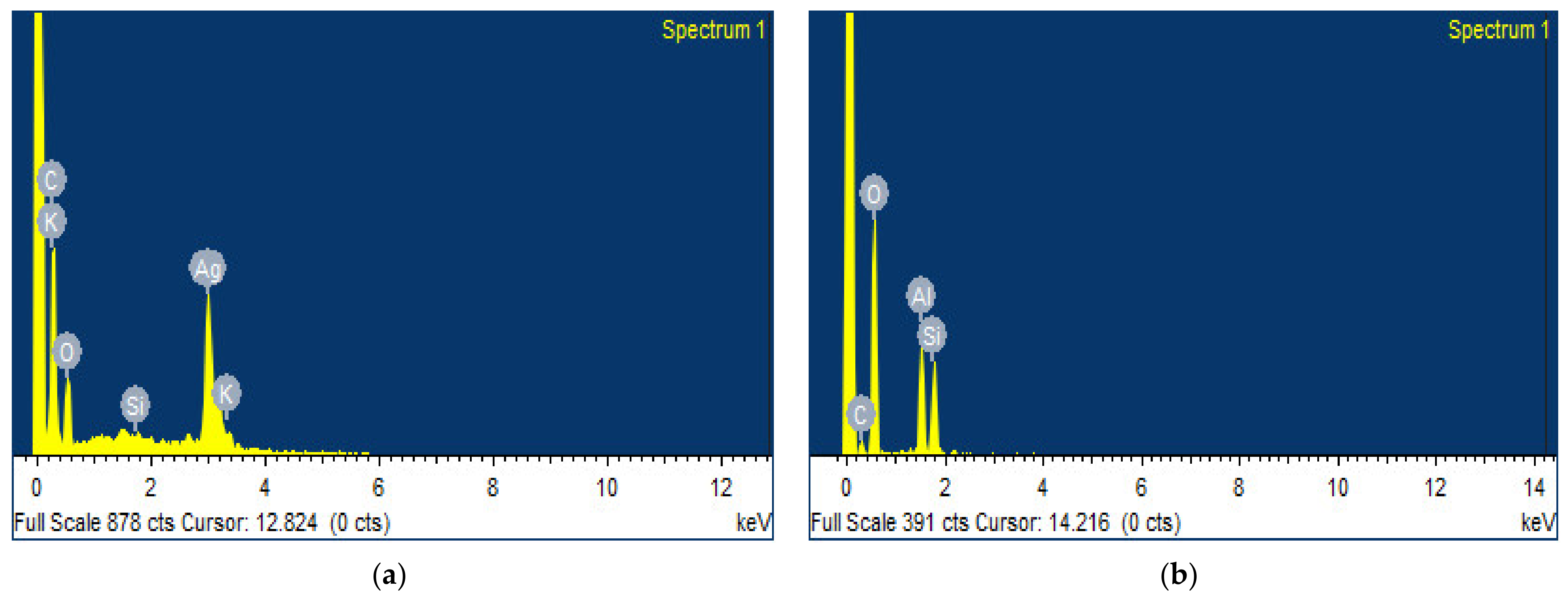
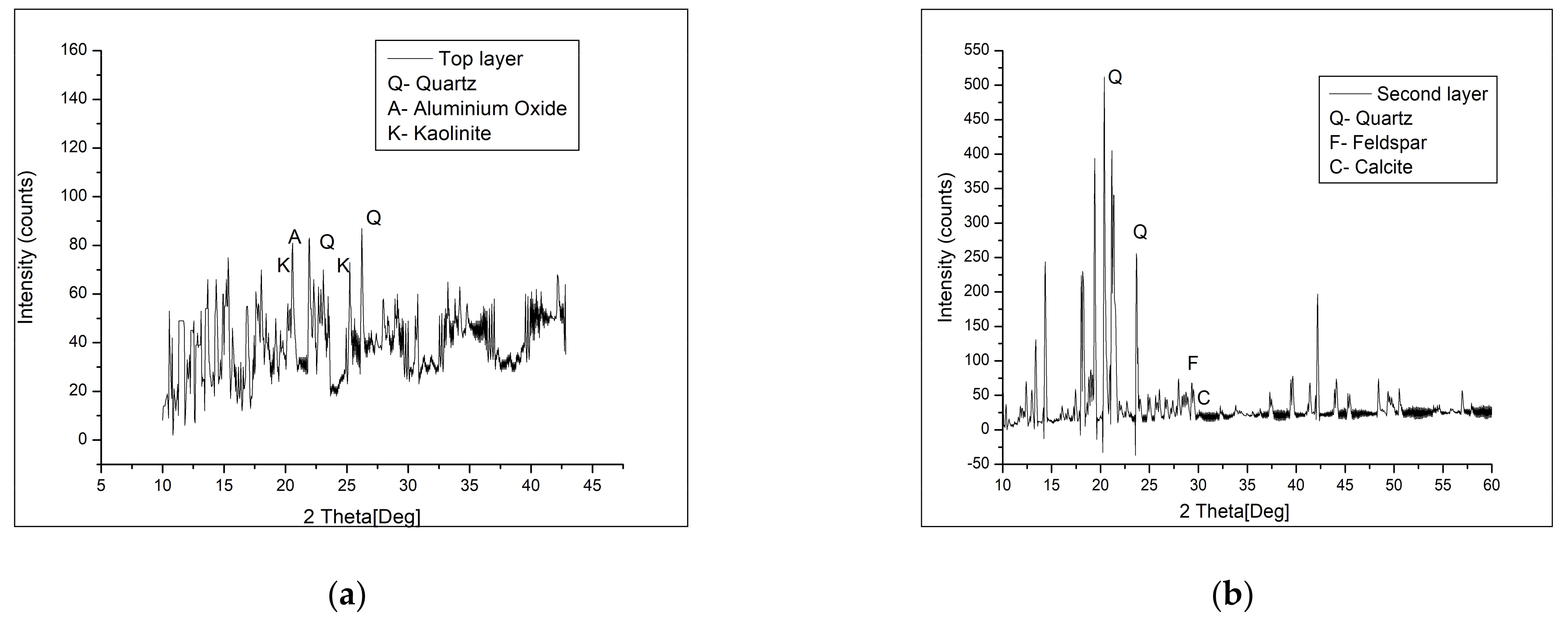

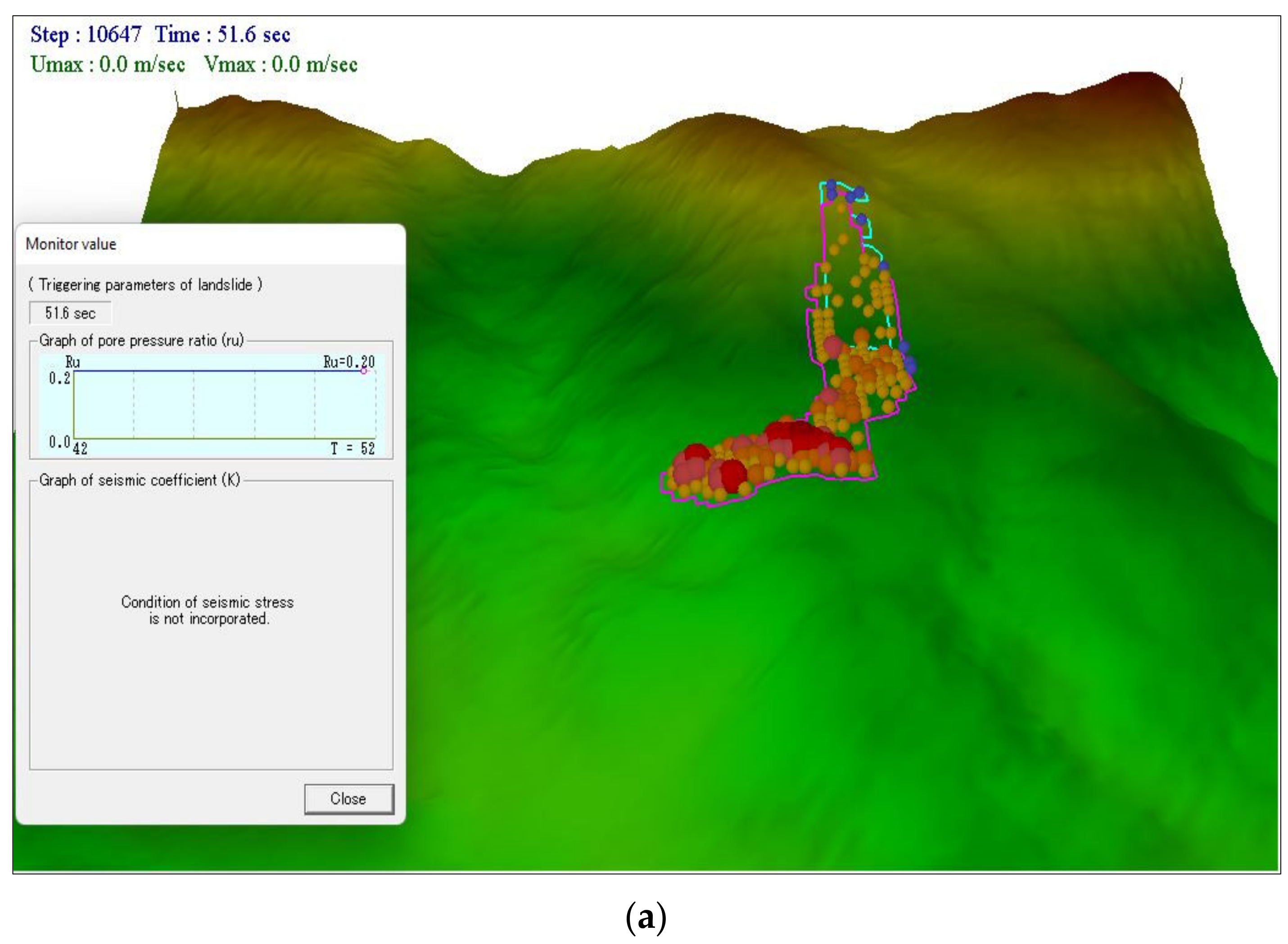
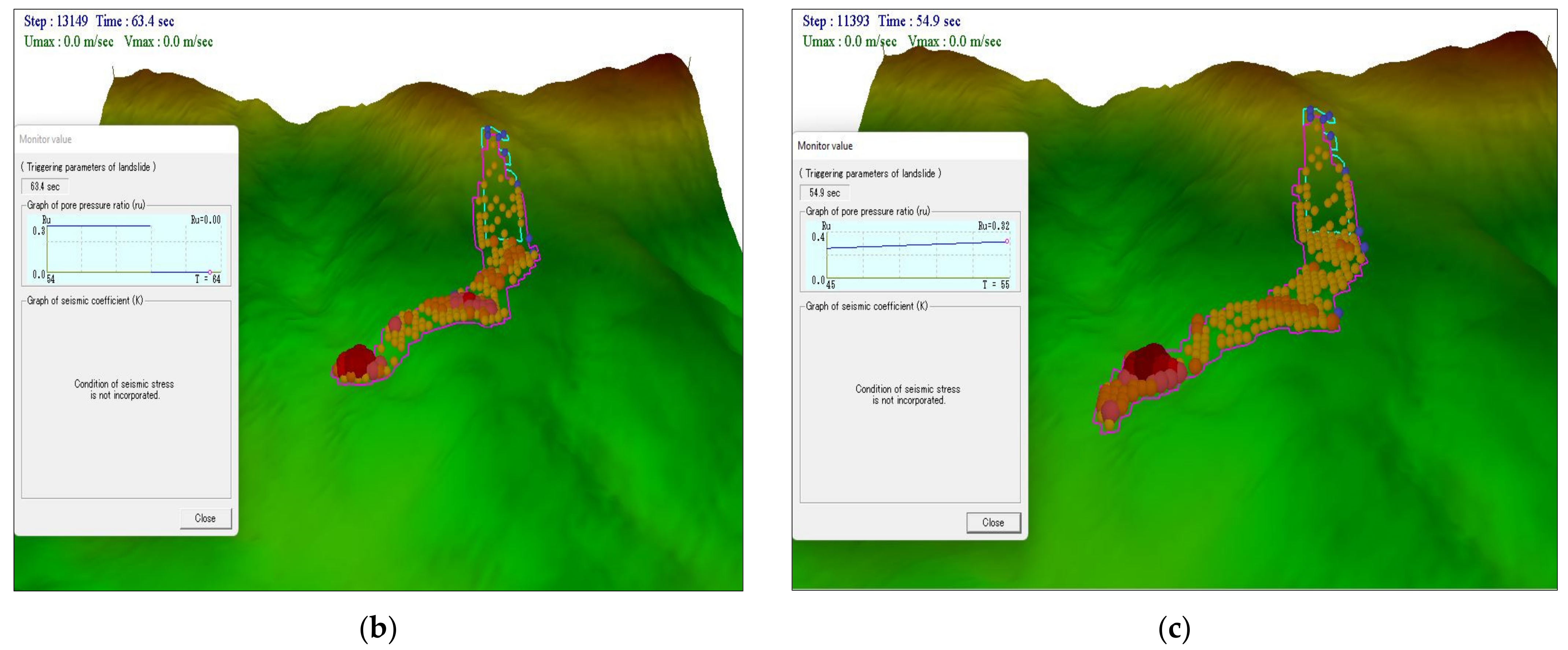
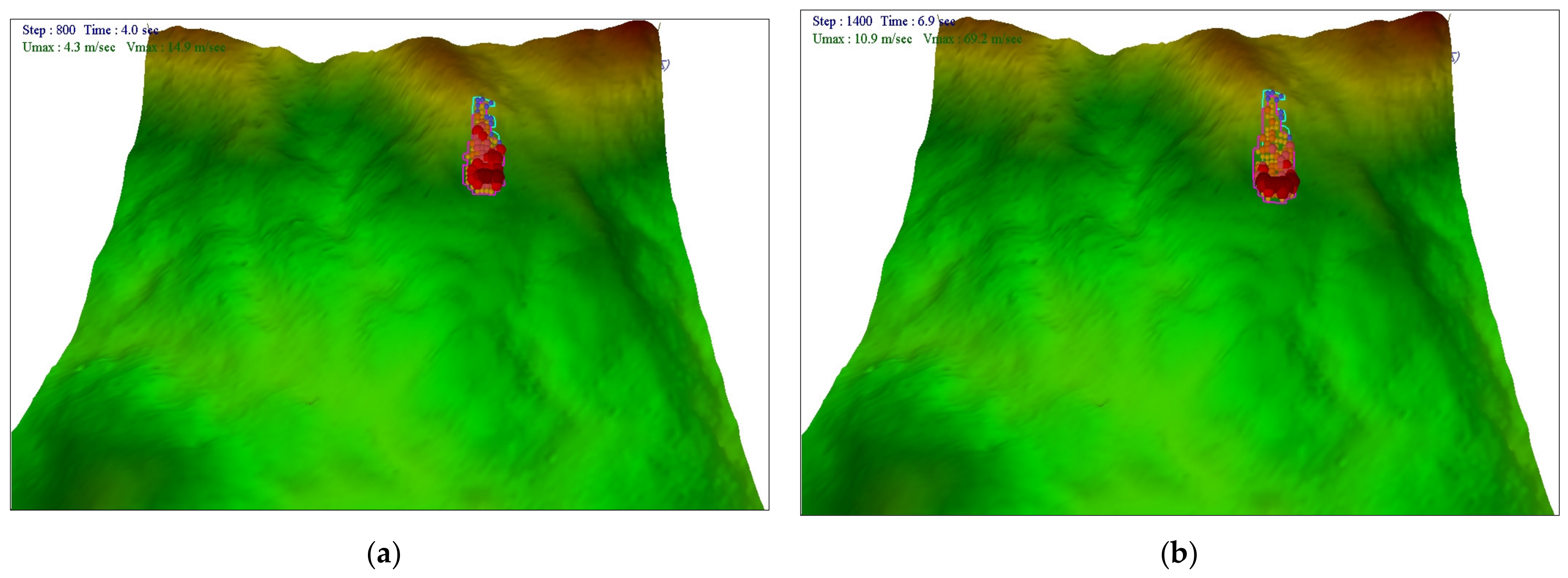
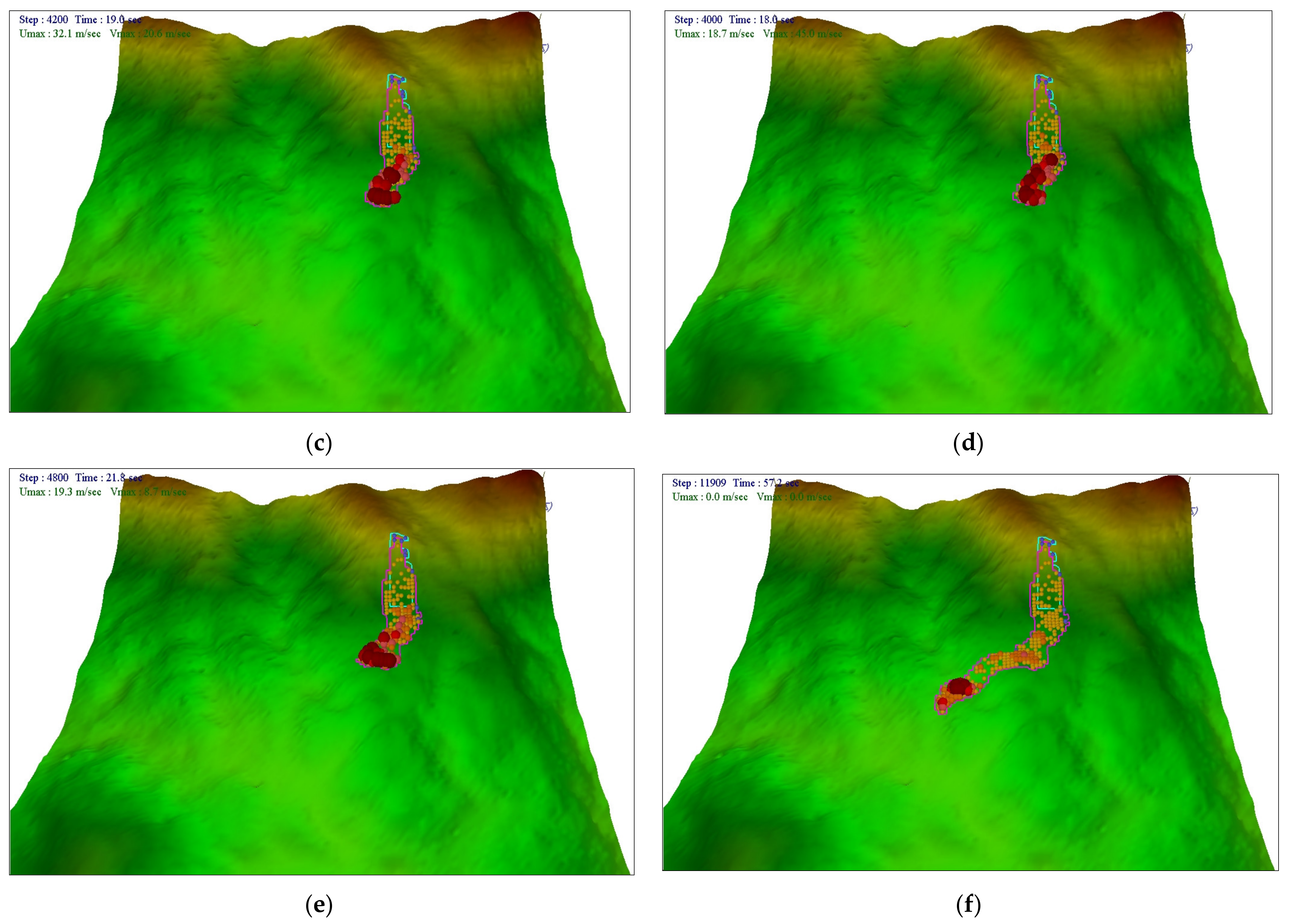

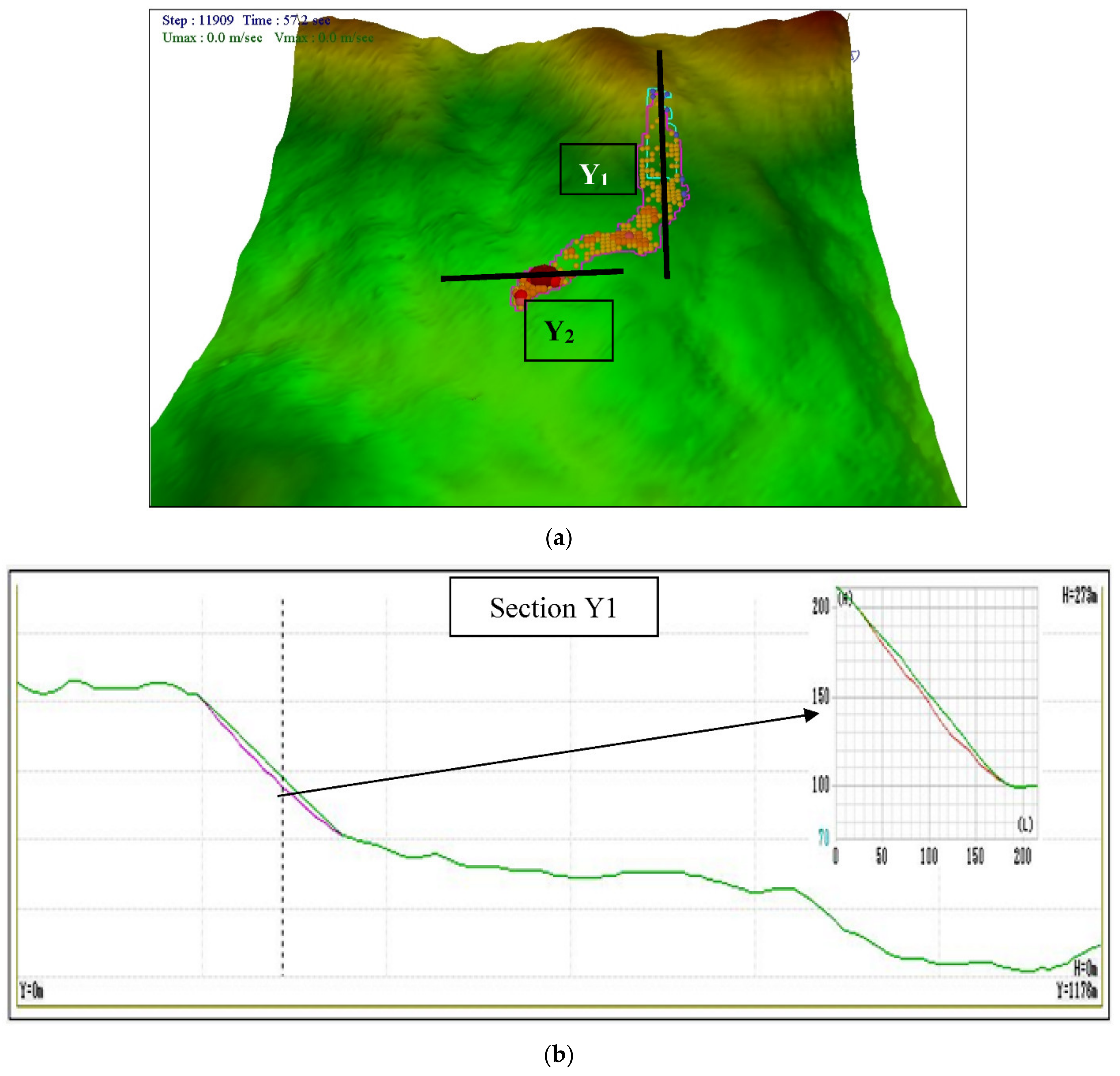
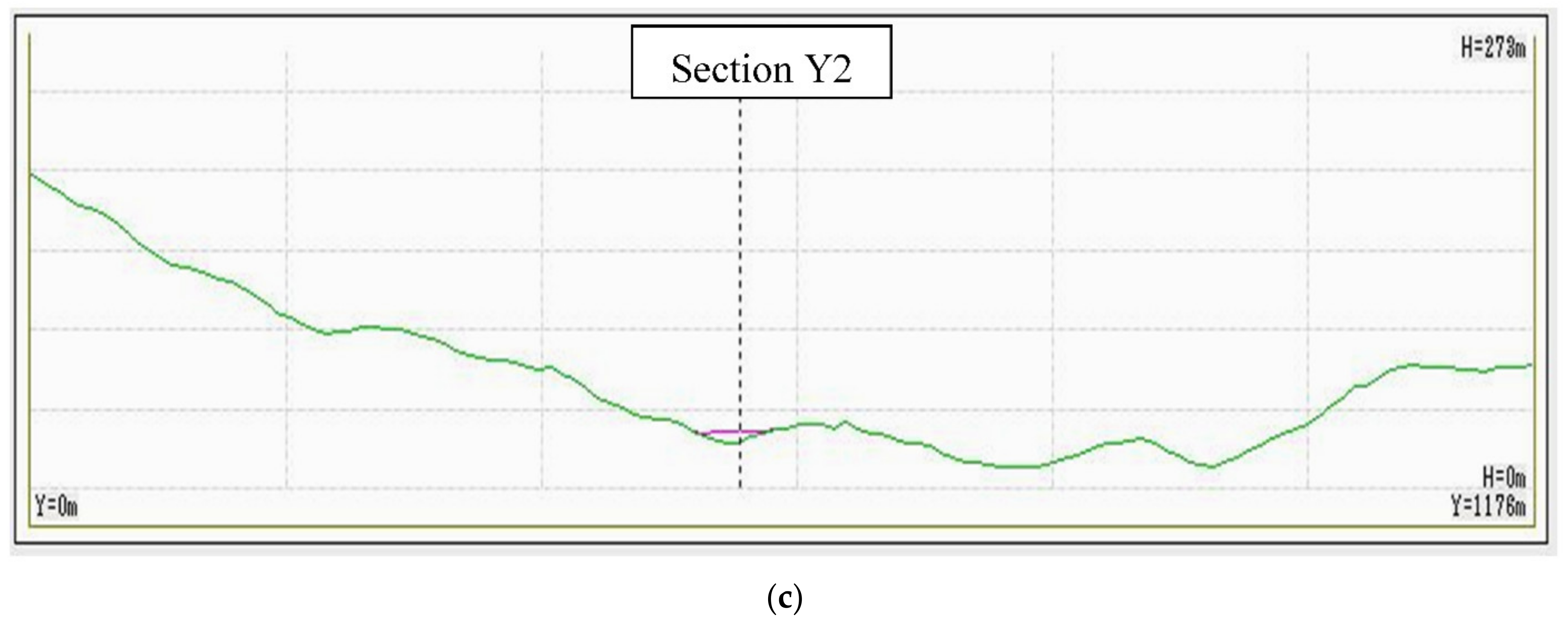
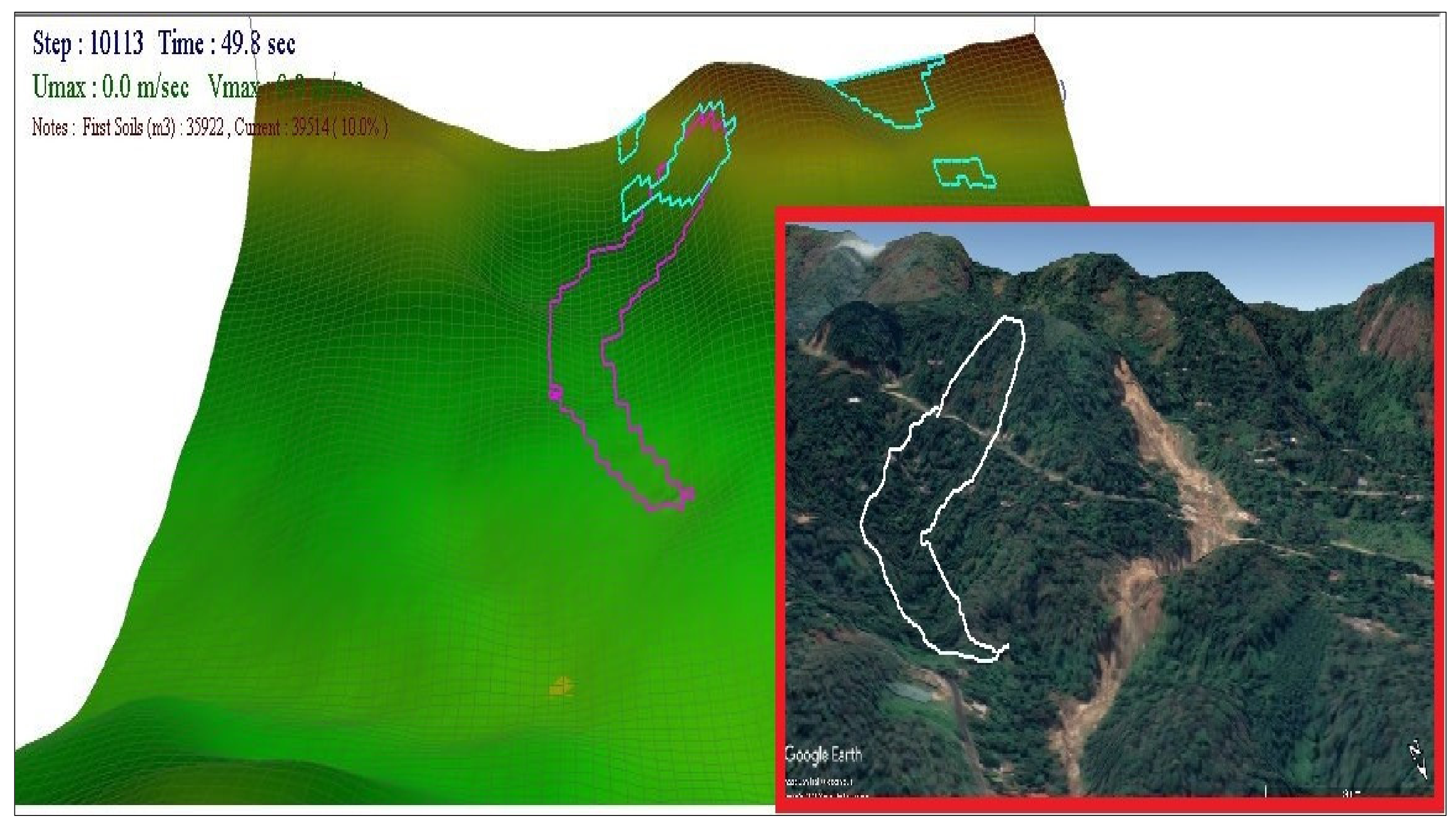
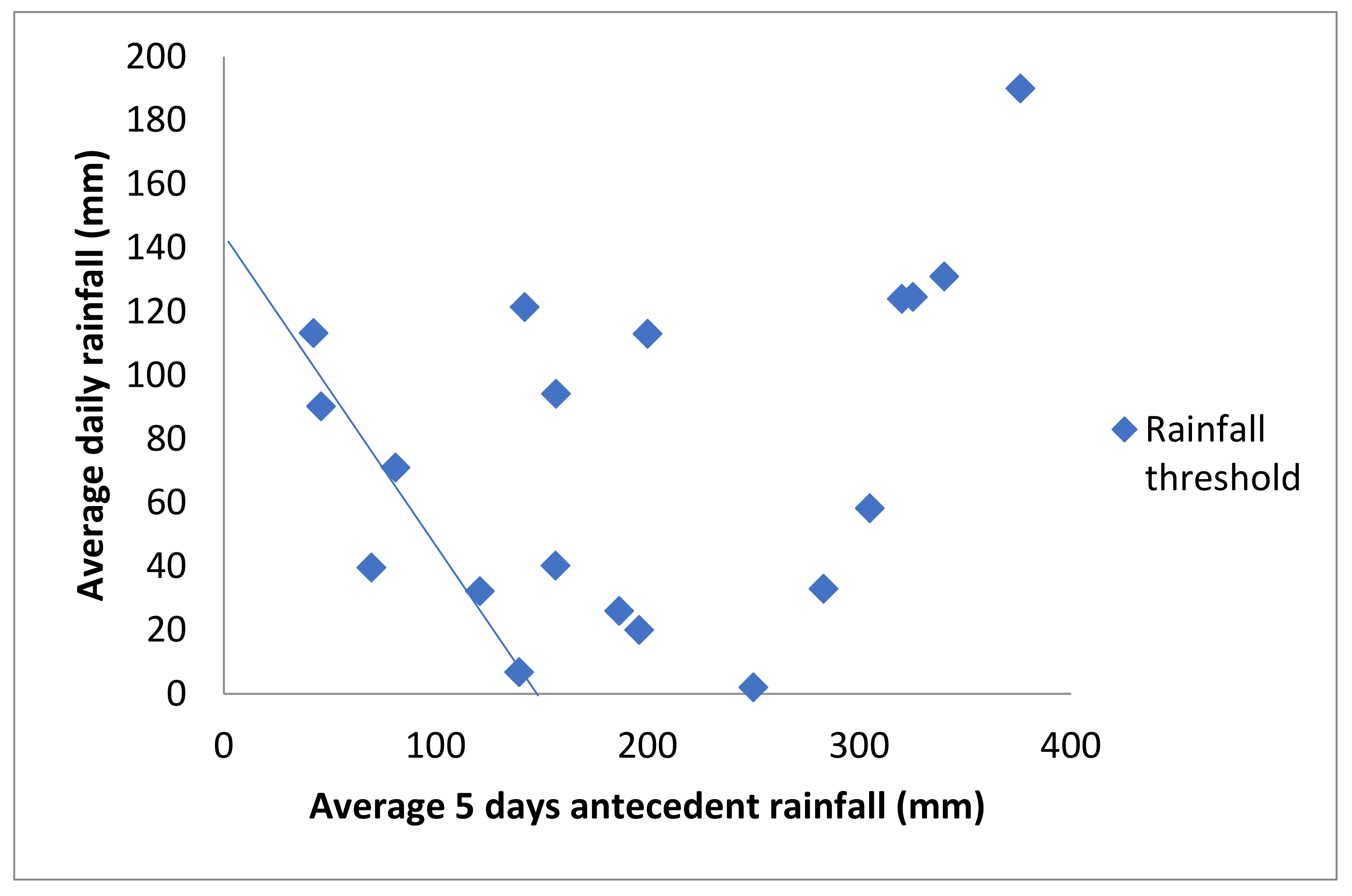
| Property | Layer 1-Soil | Layer 2-Soil |
|---|---|---|
| Specific gravity (G) | 2.55 | 2.67 |
| Liquid limit (wl) (%) | 44 | - |
| Plastic limit (wp) (%) | 34 | - |
| Plasticity index (Ip) (%) | 10 | - |
| Soil classification | SM | SP |
| Coefficient of permeability (k) (m/s) | 5.54 × 10−7 | 1.88 × 10−4 |
| Effective cohesion (c’) (kN/m2) | 9 | 0 |
| Effective friction angle (φ’) (°) | 25 | 32 |
| Elastic modulus (E) (kN/m2) | 14 × 103 | - |
| Unit weight (γ) (kN/m3) | 18.55 | 19.6 |
| Dilatancy angle (ψ) (°) | 0 | 0 |
| Properties | Upputhode |
|---|---|
| Peak friction angle (φp) (°) | 26 |
| Residual friction angle (φm) (°) | 21.89 |
| Steady-state shear resistance τss (kN/m2) | 8.75 |
| Shear displacement at the start of strength reduction DL (mm) | 28 |
| Shear displacement at the end of strength reduction DU (mm) | 190 |
| Depth of Soil Mass (Δhcr) (m) | ru (Pore Water Pressure Ratio) | Volume (m3) |
|---|---|---|
| 0.45 | 0.52 (worst-case scenario) | 64,877 |
| 0.95 | 0.52 (worst-case scenario) | 96,048 |
| 1.7 | 0.52 (worst-case scenario) | 1,26,871 |
| 1.7 | 0.2 | 72,783 |
| 1.7 | 0.3 | 87,853 |
| 1.7 | 0.35 | 96,621 |
| Parameters | Value |
|---|---|
| Mass distribution (accumulation of soil) in depth after landslide (near building) | 0.7 m |
| Accumulate mass displacement of soil in displacing building | 100 m |
| Maximum velocity ) of the soil displacing building | 400 m/s |
Publisher’s Note: MDPI stays neutral with regard to jurisdictional claims in published maps and institutional affiliations. |
© 2021 by the authors. Licensee MDPI, Basel, Switzerland. This article is an open access article distributed under the terms and conditions of the Creative Commons Attribution (CC BY) license (https://creativecommons.org/licenses/by/4.0/).
Share and Cite
Andrewwinner, R.; Chandrasekaran, S.S. Investigation on the Failure Mechanism of Rainfall-Induced Long-Runout Landslide at Upputhode, Kerala State of India. Land 2021, 10, 1212. https://doi.org/10.3390/land10111212
Andrewwinner R, Chandrasekaran SS. Investigation on the Failure Mechanism of Rainfall-Induced Long-Runout Landslide at Upputhode, Kerala State of India. Land. 2021; 10(11):1212. https://doi.org/10.3390/land10111212
Chicago/Turabian StyleAndrewwinner, Rajkumar, and Sembulichampalayam Sennimalai Chandrasekaran. 2021. "Investigation on the Failure Mechanism of Rainfall-Induced Long-Runout Landslide at Upputhode, Kerala State of India" Land 10, no. 11: 1212. https://doi.org/10.3390/land10111212





